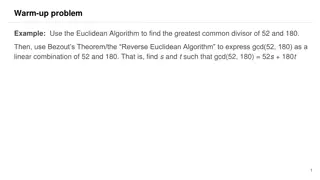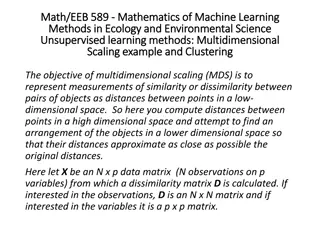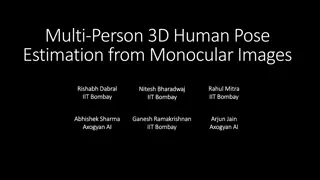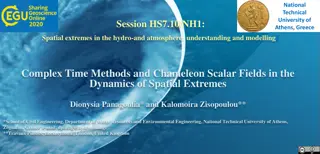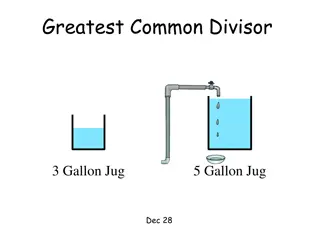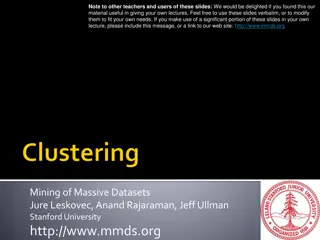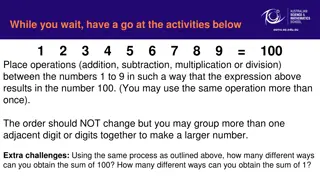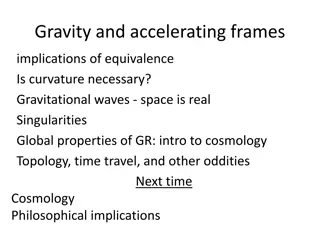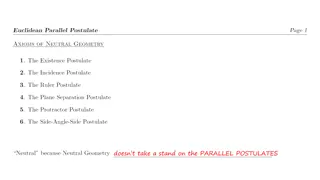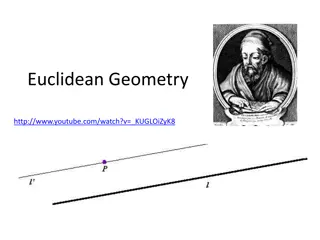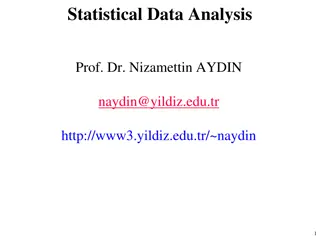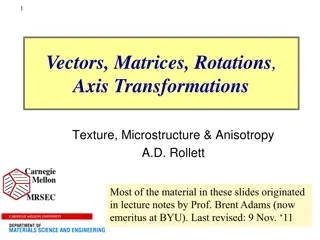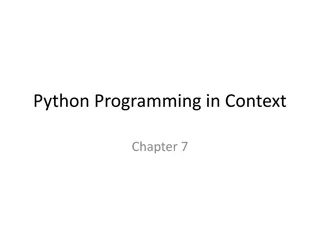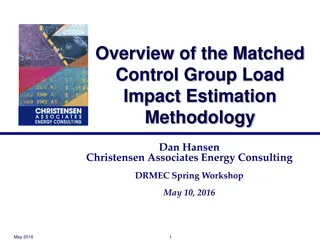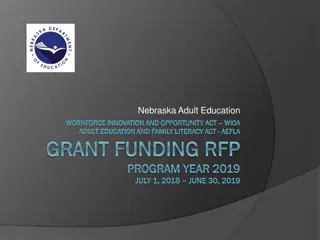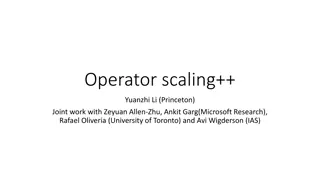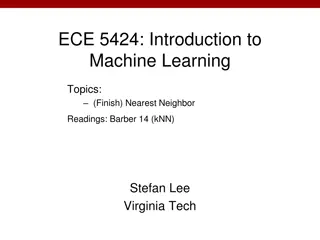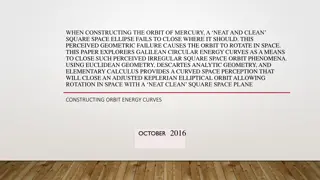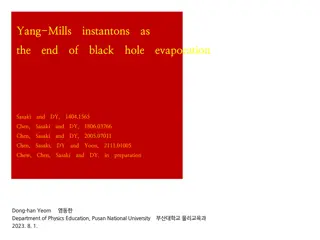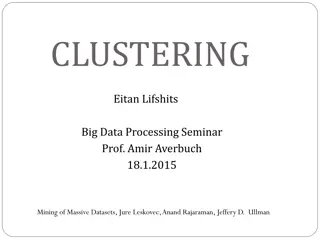Linear Congruences and the Euclidean Algorithm in Number Theory
Exploring concepts of linear congruences using examples like finding times congruent to 2 o'clock and applying the Euclidean Algorithm to determine the greatest common divisor of 52 and 180. Learn about Bezout's Theorem for expressing GCD as a linear combination of the given numbers.
6 views • 26 slides
Multidimensional Scaling and Unsupervised Learning Methods
Multidimensional scaling (MDS) aims to represent similarity or dissimilarity measurements between objects as distances in a lower-dimensional space. Principal Coordinates Analysis (PCoA) and other unsupervised learning methods like PCA are used to preserve distances between observations in multivari
5 views • 21 slides
3D Human Pose Estimation Using HG-RCNN and Weak-Perspective Projection
This project focuses on multi-person 3D human pose estimation from monocular images using advanced techniques like HG-RCNN for 2D heatmaps estimation and a shallow 3D pose module for lifting keypoints to 3D space. The approach leverages weak-perspective projection assumptions for global pose approxi
14 views • 8 slides
Hyperbolic Geometry and Tiling Patterns
Dive into the fascinating world of hyperbolic geometry, where angles in a triangle are less than 180 degrees and tilings exhibit negative curvature. Discover the beauty of the Hyperbolic Plane and learn about regular hyperbolic tilings characterized by Schlafli Symbols. Explore different models like
5 views • 46 slides
Spatial Extremes: Complex Time Methods in Hydro-Atmospheric Dynamics
This study explores the use of complex time methods and chameleon scalar fields in understanding and modeling spatial extremes in hydrological and atmospheric systems. By transforming Lagrangian processes and introducing chameleon scalar fields, the research unveils new insights into the mechanism g
1 views • 9 slides
Greatest Common Divisor and Euclidean Algorithm
Learn about the concept of greatest common divisors (GCD), how to compute them efficiently using the Euclidean Algorithm, the Quotient-Remainder Theorem, and the properties of common divisors. Explore examples and applications of GCD, extending to linear combinations, prime factorization, and other
5 views • 45 slides
Cryptography: Basic Concepts in Number Theory and Divisibility
This text delves into the fundamental concepts of number theory, divisibility, and finite fields essential for understanding cryptography. It covers topics such as divisibility, properties of divisibility, the division algorithm, the Euclidean algorithm for determining the greatest common divisor, a
3 views • 35 slides
Cryptography and Number Theory Crash Course
Background on the use of number theory in constructing key exchange protocols, digital signatures, and public-key encryption. Covers notation, modular arithmetic, greatest common divisor, modular inversion, invertible elements, and solving modular linear equations efficiently using the extended Eucl
4 views • 45 slides
Data Structures in High-Dimensional Space
Explore the concept of clustering data points in high-dimensional spaces with distance measures like Euclidean, Cosine, Jaccard, and edit distance. Discover the challenges of clustering in dimensions beyond 2 and the importance of similarity in grouping objects. Dive into applications such as catalo
1 views • 55 slides
Mathematical Discoveries at PMEG 2023
Explore the world of math through workshops, activities, and project presentations at PMEG 2023. Dive into Euclidean Geometry, straight lines, Monopoly, Fibonacci, Cartesian Planes, linear equations, and binary code with our dynamic teams. Unveil the possibilities of mathematical exploration!
3 views • 5 slides
Implications of Gravity and Accelerating Frames in General Relativity
Delve into the fascinating world of General Relativity as we discuss the equivalence principle, gravitational waves, properties of spacetime, and the effects of curvature in the presence of gravity. Discover how Einstein's revolutionary theories have reshaped our understanding of the universe, leadi
10 views • 15 slides
Different Geometries and Parallel Postulates
Explore the realms of Euclidean, Hyperbolic, and Elliptic geometries along with their unique characteristics, axioms, and the implications of the parallel postulates. Delve into the distinctions between these geometries and the intriguing concept of mixing Euclidean and Hyperbolic geometries within
2 views • 6 slides
Euclidean Geometry and the Pythagorean Theorem
Explore the foundations of Euclidean Geometry, delve into the Pythagorean Theorem, discover the postulates of Euclid, and learn about distance functions, Euclidean distance, taxi-cab metric, circles, and isometries and congruence. Unravel the rich history, key principles, and practical applications
5 views • 37 slides
Cluster Analysis in Statistical Data Analysis
Cluster analysis is a vital method in statistical data analysis that aims to identify subgroups within a population based on similarities between observations. It involves techniques like building regression models for supervised learning and utilizing distance measures for assessing dissimilarity.
2 views • 25 slides
Vectors, Matrices, and Rotations in Euclidean Space
Explore the fundamentals of vectors, matrices, rotations, and coordinate transformations in Euclidean space. Learn about points, tensors, and the significance of vectors in representing physical quantities. Discover the Parallelogram Law and Coordinate Frames for effective visualization and computat
3 views • 46 slides
Quantum Mechanics and Geometric Interpretations in Weyl Space
The discussion explores Weyl quantum mechanics, Bohm's interpretation of quantum potential, and geometric formulations in Euclidean-Weyl space. It delves into the implications of nonlocal quantum potentials and the nature of metric spaces in shaping quantum phenomena. Concluding with alternative vie
0 views • 30 slides
Python Data Mining and Cluster Analysis in Context
This chapter delves into using Python lists for data storage, implementing data mining applications, and exploring cluster analysis. Learn about clusters, centroids, Euclidean distance, visualization, and how to write functions for data analysis. The concepts of indefinite iteration and loop control
2 views • 27 slides
Matched Control Group Load Impact Estimation Methodology Overview
A matched control group consists of customers similar to those in a treatment group but not subjected to the treatment. This methodology is useful when an experimentally designed control group is unavailable, there is a large pool of eligible control customers, or the treatment is not event-based. T
4 views • 12 slides
Defense Against Adversarial Images using Web-Scale Nearest-Neighbor Search
This study explores a method to defend against adversarial images by approximating their projection onto the image manifold through nearest-neighbor search. The approach involves finding the nearest neighbors in a web-scale image database to classify and mitigate the impact of adversarial perturbati
4 views • 15 slides
Euclidean Path Integral & Statistical Ensembles
Euclidean Path Integral & Statistical Ensembles cover topics such as phase transitions, regularity conditions, and gauge potential regularity. In Quantum Field Theory, the path integral is defined and governed by saddle point approximation, leading to thermodynamic quantities like internal energy an
2 views • 57 slides
Euclidean Path Integral Insights: Dyonic Taub-NUT-AdS Phases
Unlock the complexities of Euclidean Path Integral in Dyonic Taub-NUT-AdS Phases and delve into thermal field theory, gauge potential regularity, statistical ensembles, and phase transitions. Explore the nuances of quantum field theory and the fascinating world of gravitational metrics. Discover the
0 views • 22 slides
Insights into General Relativity and Black Holes
Delve into the fascinating principles of general relativity, including the equivalence of gravitational and inertial mass, the apparent curvature of light, gravitational lensing, and the mysterious nature of black holes. Explore how mass distorts space and the non-Euclidean geometry underlying our u
0 views • 29 slides
Operator Scaling by Yuanzhi Li and Collaborators: Group Actions & Orbit Intersection Problems
This paper delves into the fascinating realm of operator scaling discussed by Yuanzhi Li from Princeton University in collaboration with other researchers. The focus is on group actions and problems related to orbit intersection, offering insight into graph isomorphism, complexity levels, and an eff
3 views • 60 slides
Conformal Geometric Algebra for Homogeneous Geometry
This content delves into the exploration of treating points as vectors in a homogeneous viewpoint, emphasizing the significance of preserving geometric meaning despite scaling. It discusses the direct interpretation of the inner product of vectors as the distance between points, aiming to meet vario
4 views • 24 slides
Introduction to Machine Learning: Nearest Neighbor Methods
This content delves into memory-based learning with a focus on nearest neighbor algorithms. It covers topics like distance metrics, number of neighbors, weighting functions, and local point fitting. Visual representations and examples enhance the discussion, offering insights into regression and mul
5 views • 24 slides
Uniform Semimodular Lattice & Valuated Matroid Insights
Dive into the intricate world of Uniform Semimodular Lattices and Valuated Matroids as discussed in the research by Hiroshi Hirai at the University of Tokyo. Explore the connections to Euclidean building and combinatorial geometries, offering a fresh perspective on geometric structures and matroid t
4 views • 25 slides
Guidelines for Assignment 5
Learn about representing images as vectors, calculating distances using Euclidean and Manhattan methods, and classifying images with the nearest neighbor algorithm. Understand the vector representation of images and the concepts of Euclidean and Manhattan distances. Explore the nearest neighbor clas
4 views • 35 slides
Algorithms for Big Data: Special Topics on CSCE 689
This course covers advanced algorithms for handling big data, focusing on topics such as Euclidean space, CountSketch, ?2 estimation, moment estimation, Johnson-Lindenstrauss lemma, and algorithm implementation. Dive into the intricacies of Euclidean space, distance functions, heavy-hitters problems
3 views • 35 slides
Constructing Curved Space Orbits with Energy Curves and Gfield Systems
This paper delves into the geometric complexities of constructing the orbit of Mercury, exploring Galilean energy curves to rectify perceived irregularities in square space ellipses. Through Euclidean and analytic geometry, alongside elementary calculus, a curved space perception is introduced to ap
0 views • 13 slides
Efficient Euclidean Pathfinding Among Polygonal Obstacles
This research presented at SODA 2021 introduces a solution for finding the shortest Euclidean path between two points in a free space containing polygonal obstacles. By dividing the algorithm into phases and using persistent binary trees, the space complexity is reduced to O(n log n), significantly
0 views • 15 slides
Exploring Euclidean Path-Integral Approach in Black Hole Information Theory
Delve into the concept of black hole information emissions through quantum extremal surfaces, the subtleties of interpreting path-integrals, and embedding images into orthodox path integral formulations. Follow the Euclidean path-integral approach, analyze steepest-descent approximations, and explor
0 views • 45 slides
Comparing Clustering Algorithms and Distance Metrics in Machine Learning
Explore the k-means clustering algorithm and other prominent techniques in machine learning. Dive into the similarities, differences, advantages, and disadvantages of algorithms like k-means++, canopy clustering, and farthest-first clustering. Learn about essential distance metrics such as Euclidean
21 views • 8 slides
Clustering in Big Data Processing: Overview & Algorithms
Explore the concept of clustering in big data processing, covering topics such as distance measures, algorithmic approaches, and the challenges of high-dimensional data. Learn about hierarchical clustering, point assignment algorithms, and different distance measures like Euclidean, Jaccard, and Cos
0 views • 50 slides
Similarity and Dissimilarity Measures in Data Mining
This content covers similarity and dissimilarity measures, including numerical representations for data objects, simple attribute comparisons, Euclidean distance calculations, common properties of distances and similarities, and binary vector similarities. Explore concepts like Euclidean Distance, T
7 views • 21 slides
Mathematical Concepts in Euclidean Space
Explore various concepts in Euclidean space such as distances, vectors, dot products, and collinearity, illustrated with examples and visuals.
3 views • 21 slides
Data Encryption and Linear Algebra Techniques at Mustansiriyah University Engineering College
Explore concepts in data encryption, linear algebra, and the Extended Euclidean Theorem taught by Dr. Fatimah Al-Ubaidy at Mustansiriyah University's Engineering College. Learn how to find the greatest common divisor, use the Extended Euclidean algorithm to find linear combinations of numbers, and d
3 views • 4 slides
Understanding Clustering in Dimensional Spaces
Explore the challenges of clustering in multi-dimensional spaces, the impact of distance measures between points, and the complexities of high-dimensional data analysis. Dive into the nuances of Euclidean and non-Euclidean spaces, and discover the intricacies of measuring distances in varied dimensi
2 views • 54 slides
Data Encryption and Multiplicative Inverse in Computer Engineering Algebra
Explore concepts in data encryption and computer engineering algebra, covering topics like the Extended Euclidean Theorem, finding GCD using factorization, linear combination of numbers, and calculating multiplicative inverses. Dr. Fatimah Al-Ubaidy guides students through examples and explanations
1 views • 4 slides
Vector Operations in Euclidean Space
Explore concepts like distance calculation, vector norms, dot product, and collinearity in Euclidean space involving vectors and coordinates.
1 views • 21 slides
Understanding Clustering in Data Analysis
Delve into the intricacies of clustering in data analysis, where points are grouped into clusters based on distance measures. Explore methods for discovering clusters in diverse data sets, including challenges in clustering high-dimensional or non-Euclidean spaces. Learn about distance measures, suc
1 views • 54 slides
